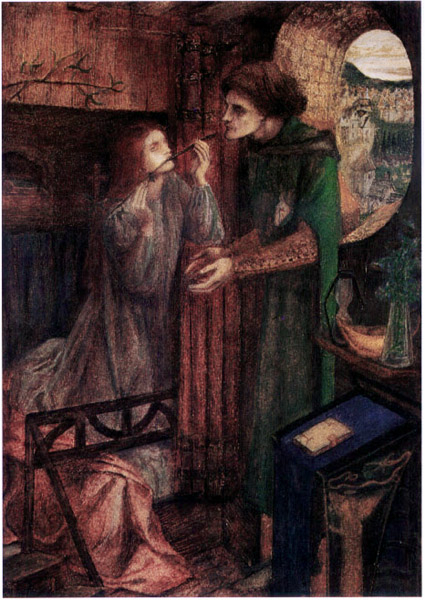I have been notoriously lax in my advancement of the feminist cause. I just assume that women were far more active historically than they have been portrayed. Those who control the media control the message. But at the same time I do notice when women have important public roles to play, and in writing fiction I have made sure that my Victorian females have a great deal of agency.
That’s not wishful thinking. It’s simply that the ordinary academic practice of history tends to believe its sources, without looking at all of them. That’s human. So I just want to say up front, it takes quite a bit to get my feminist hackles up. I’m a humanist.
But as I look into the Pre-Raphaelites, I have found myself getting annoyed with the focus on the men. Rossetti, Burne-Jones, Millais — there are women who took their names, but they are seen as muses alone. No one says “Rossetti” and means Christina, Dante Gabriel’s highly published and respected poet sister. No one says Millais and means Lady Millais, or “Burne-Jones” and means Georgina, an accomplished artist, or “Morris” and means Jane, a talented embroiderer. Why, when most of them published or exhibited their own work? I’m not even sure the men themselves saw them as sidelines — there is much evidence of respect and collaboration. And yet in most of the books, the men’s work is emphasized, and the women’s downgraded. Most of the explorations of the women’s work are recent, like Jan Marsh’s Pre-Raphaelite Sisters, or the National Portrait Gallery exhibit.
For inspiration and amusement, I’ve been looking at the portrayal of the Pre-Raphaelites in cinema and television, so I’m watching Desperate Romantics. It was made in 2009, not exactly a bad time for feminism. But even there, little mention is made of anything the women themselves created or exhibited. I realize it’s set early (1850s), but the writer didn’t even imbue them with any ambition.
 Jane Morris embroidery |
 by Georgiana Burne-Jones |
 Clerk Saunders, by Elizabeth Siddall |
I thought perhaps I’d look into their lives a bit, see whether they would make good characters in my book, or whether the tale I’ll tell could be through their eyes, instead of the men’s. I don’t know much about the art history of this period, so I’m investigating. My book is set in 1863, so I thought I’d see what the Royal Academy of Arts was doing then. I found The Royal Summer Exhibition: A Chronicle, a great resource that for 1863 discussed several of the key works including Millais, comparing his dark work in The Eve of St Anges to the lightness of a painting by Edward Matthew Ward. And then I saw in the Context section:
For some critics, Henrietta Ward’s picture of Mary Queen of Scots surpassed her husband’s efforts, and the Mutrie sisters were described as “still supreme among flower-painters”.
Who’s Henrietta Ward? I tried to search her by name and “Mary Queen of Scots”. I found an engraving from the Illustrated London News of it, but not the painting. So then I found the Royal Academy of Arts catalogue for that exhibition on HathiTrust. I wondered whether she’d be listed like the male painters, as “H. Ward”. I found the work, and her name as “Mrs. E. M. Ward”, and she had half a dozen works in the exhibition. I looked her up at the NPG, but there’s not a lot there. I found a review in the Athaeneum, which said:

They used “Mrs.” but referred to the artist as a male. How strange.
I thought I’d pick at random another female, since they are so clever indicated with “Miss” and “Mrs.” Item 571, Always welcome, by Mrs. J. F. Pasmore. Started searching on Google. “Mrs. J. F. Passmore painting 1863”. Very frustrating. I had spelled the name wrong. Then I stumbled on this at an antiques dealer site:

And here’s the description:

Middle initial and last name spelling confusion aside, she “also exhibited paintings”? Hers is in the Royal Academy exhibition, but I can’t find a copy of Always welcome online (there are plenty of paintings around by John F., mostly for sale). And this website attributes the above painting to him anyway, not her. So now I don’t know what to think. Maybe this is just a picture of her.
I don’t like to class everyone together: all women, all men. Some women had extraordinary power, both in the home and out of it. Others were taken advantage of. This sort of problem makes one wonder whether it’s the sources or the perception. Looking at the sources, I find more and more evidence of women’s agency. But finding those sources seems inordinately difficult.